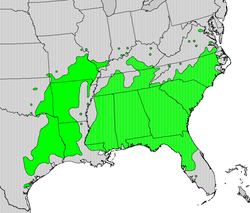Top Qs
Timeline
Chat
Perspective
Vaccinium arboreum
Species of fruit and plant From Wikipedia, the free encyclopedia
Remove ads
Vaccinium arboreum (sparkleberry or farkleberry) is a species of Vaccinium native to the southeastern and south-central United States.
Remove ads
Description
Vaccinium arboreum is a shrub (rarely a small tree) growing to 3–5 metres (10–16+1⁄2 ft), rarely 9 m (30 ft) tall,[citation needed] with a diameter at breast height of up to 35 centimetres (14 in).[4] The leaves are evergreen in the south of the range, but deciduous further north where winters are colder; they are oval-elliptic with an acute apex, 3–7 cm (1+1⁄4–2+3⁄4 in) long and 2–4 cm broad, with a smooth or very finely toothed margin.
The flowers are white, bell-shaped, and 3–4 millimetres (1⁄8–3⁄16 in) in diameter with a five-lobed corolla, produced in racemes up to 5 cm (2 in) long. The fruit is a round dry berry about 6 mm (1⁄4 in) in diameter, green at first, black when ripe, bitter and tough.[4] Cytology is 2n = 24.[5]
Remove ads
Distribution and habitat
Sparkleberry could be found in the United States from southern Virginia west to southeastern Nebraska, south to Florida and eastern Texas, and north to Illinois.[6][7] It grows in sandy and rocky habitats, including dry woods. It also grows on a variety of moist sites such as wet bottomlands and along creek banks.[4]
Ecology
The berries are eaten by various wildlife.[8]
Uses
Because of its relative hardiness in comparison to other Vaccinium species, V. arboreum has been investigated as a potential rootstock for expanding the range of blueberry cultivation to less acidic soils (pH>6.0) and reducing the severity of bacterial leaf scorch.[9]
References
External links
Wikiwand - on
Seamless Wikipedia browsing. On steroids.
Remove ads



